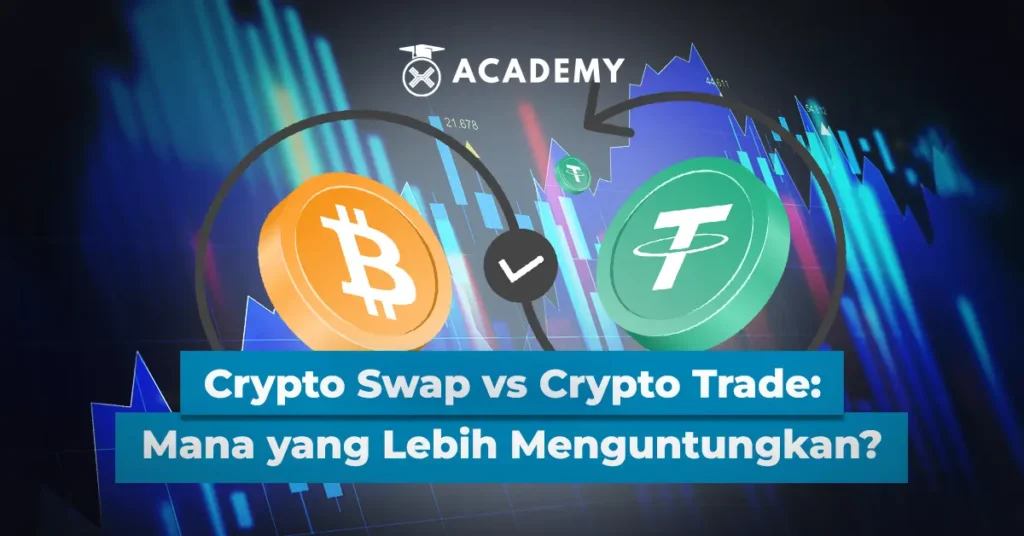Cryptocurrency or crypto assets are a topic that has attracted a lot of attention lately. This digital currency that uses blockchain technology offers a new way to transact, store, and manage assets.
Its popularity continues to increase because many people are interested in its potential security, transparency, and accessibility that it offers in various fields, including investment and trading.
In the crypto world, understanding certain terms is very important, especially for investors and users.
Terms such as “swap” and “trade” often appear in the context of digital transactions and have special meanings that need to be understood so that users can make the right decisions.
By recognizing and understanding these terms, avoiding mistakes in transactions can be avoided. In addition, users can also maximize the potential of their crypto investments.
What is Crypto Swap?

Crypto swap is a process that allows for the direct exchange of one type of cryptocurrency for another.
This is different from the conventional method, where users must first sell their crypto assets into fiat money before using the funds to buy other crypto.
With crypto swap, this exchange process becomes more efficient because it is done without the need for fiat currency.
Not only does it shorten the transaction steps, this process can also reduce the costs that usually arise in the traditional conversion process.
Types of Platforms for Swaps
In the crypto world, various platforms have been developed to facilitate the process of swapping or exchanging digital assets.
Each platform has different characteristics, both in terms of the operating system and the level of control given to users.
Here are some types of platforms that are often used to make swaps in the crypto ecosystem that you need to know.
Centralized Exchanges (CEX)
This centralized platform provides swap services with high liquidity support. In CEX, transactions are carried out through intermediaries who manage and secure user assets.
Decentralized Exchanges (DEX)
DEX is a platform without intermediaries that allows users to exchange crypto assets directly.
Examples of this platform are Uniswap and PancakeSwap, which give users the freedom to swap between cryptos without the involvement of a third party, increasing user privacy and control over their assets.
What are the Advantages and Risks of Crypto Swaps?
Crypto swaps have several advantages for users who want to exchange their crypto assets directly. However, there are also a number of risks that need to be considered.
Here are some of the advantages and risks that need to be considered in doing a crypto swap.
The advantages
The exchange process is faster and costs less than traditional buying and selling methods.
There is no need to convert crypto assets to fiat currency in the transaction process.
Crypto Swap Risks
The high volatility of crypto prices can affect the exchange rate when the swap is carried out.
Potential risks in transactions via smart contracts on DEX, such as bugs or vulnerabilities in the code.
Transaction fees (gas fees) that can be high, especially on the Ethereum network.
What is Crypto Trade?

Crypto trade is the activity of buying and selling crypto assets on the market to make a profit. In this trade, users buy crypto with the aim of selling it back when the price goes up, or vice versa.
Then, users can also sell the crypto they own to profit from lower price movements.
The main difference between trade and swap lies in the purpose and method of the transaction. Crypto trade is known to focus more on buying and selling crypto for short or long-term profits based on market price fluctuations.
On the other hand, crypto swap is the process of directly exchanging one type of crypto with another type of crypto without involving fiat money, usually more efficient for exchanges between cryptos with lower costs.
Types of Crypto Trading
Crypto trading encompasses a variety of methods that allow users to buy, sell, and speculate on the price of crypto assets.
Each type of trading has different characteristics and strategies, depending on the goals and level of risk a trader is willing to take. Here are some types of crypto trading that are commonly used in the crypto market.
1. Spot Trading
Spot trading is the process of buying and selling crypto assets directly using fiat currency or between cryptos. Transactions are made at the current market price, and the purchased assets are immediately received by the buyer.
2. Margin Trading
A type of trading that uses loans, where users can trade with leverage. With that, users can increase the potential for profit (or loss) although it also carries a higher risk.
3. Futures Trading
Futures trading or futures contract trading that allows speculation on the price of crypto assets in the future. Traders buy or sell contracts to buy crypto at a certain price in the future, with the aim of profiting from price changes.
Advantages and Benefits of Crypto Trade
Crypto trade provides various opportunities for traders to take advantage of market movements and make a profit. However, each type of trading carries certain advantages and risks.
Here are some of the advantages and benefits of crypto trade that are important to know:
Flexibility in choosing trading methods and instruments, such as spot, margin, or futures, which can be adjusted to the trader’s strategy and goals.
Higher profit potential by utilizing proper market analysis and use of leverage in margin or futures trading.
Crypto Trade Risks
In addition to providing many benefits, there are also several risks that need to be considered when involved in crypto trading, including:
Very high market volatility, which can cause rapid price changes and risk resulting in losses.
Technical risks, such as hacking on the platform or errors in trading, especially when using margin or futures that involve high leverage.
Difference between Crypto Swap and Crypto Trade
Crypto swap and crypto trade are two main methods of transacting crypto assets, but they differ in process, purpose, and platform usage.
Each offers different advantages and risks, depending on the strategy the user wants to implement. Here are the differences between crypto swap and crypto trade that need to be understood.
Definition and Process
- Swap: Is the process of directly exchanging one type of cryptocurrency with another without involving fiat currency.
- Trade: Includes buying and selling crypto assets, either through the market using fiat money or between cryptocurrencies, which often requires strategy and market analysis.
Purpose and Use
- Swap: Generally used to diversify assets or to take advantage of changes in value between cryptocurrencies for short-term purposes.
- Trade: Used by traders to profit from market price fluctuations, using various technical or fundamental analysis strategies.
Platforms Used
- Swap: Usually done on decentralized platforms (DEX) or centralized exchanges (CEX) that provide swap features between cryptocurrencies.
- Trade: Can be done on almost any exchange, both centralized (CEX) and decentralized (DEX), that offers a variety of trading instruments.
Risks and Costs
- Swap: The process is faster and simpler, but can be affected by price volatility and gas fees on DEXs.
- Trading: More complex and requires in-depth analysis, but offers greater opportunities for higher returns, albeit with higher risks.
Bagaimana Melakukan Crypto Swap dan Trade?
Untuk melakukan crypto swap dan trade, diperlukan pemahaman terkait platform yang digunakan dan proses yang ada di dalamnya.
Meskipun keduanya bertujuan untuk bertransaksi kripto, cara pelaksanaannya pun berbeda. Inilah panduan singkat terkait langkah-langkah yang perlu diikuti untuk melakukan crypto swap dan trade dengan efektif.
Langkah-langkah Melakukan Crypto Swap
- Pilih platform (CEX atau DEX) yang menyediakan fitur swap.
- Pilih pasangan kripto yang ingin ditukar.
- Pilih jumlah yang ingin ditukar dan pastikan untuk mengkonfirmasi transaksi.
- Periksa biaya transaksi dan pastikan saldo kamu mencukupi untuk melakukan swap.
Langkah-Langkah Melakukan Crypto Trade
- Pilih platform yang mendukung spot, margin, atau futures trading.
- Tentukan pasangan kripto atau aset yang ingin diperdagangkan.
- Gunakan analisis teknikal dan fundamental untuk menentukan titik masuk dan keluar.
- Pertimbangkan biaya transaksi dan risiko yang terkait dengan penggunaan leverage (pada margin trading).
How to Do Crypto Swap and Trade?
To do crypto swap and trade, you need to understand the platform used and the processes involved.
Although both are aimed at transacting crypto, the implementation methods are different. Here is a brief guide on the steps you need to follow to do crypto swap and trade effectively.
Steps to Do Crypto Swap
- Choose a platform (CEX or DEX) that provides the swap feature.
- Select the crypto pair you want to swap.
- Select the amount you want to swap and make sure to confirm the transaction.
- Check the transaction fees and make sure your balance is sufficient to make the swap.
Steps to Do Crypto Trade
- Choose a platform that supports spot, margin, or futures trading.
- Determine the crypto pair or asset you want to trade.
- Use technical and fundamental analysis to determine entry and exit points.
- Consider transaction costs and the risks associated with using leverage (on margin trading).
Advantages and Challenges of Using Swap and Trade
Using crypto swap and trade offers various advantages, such as ease of transaction and high profit potential.
However, each method also comes with its own challenges, such as market volatility and technical risks.
Here are some advantages and challenges to consider when using crypto swap and trade.
Swap Advantages
- Fast process and save transaction costs.
- Ideal for diversifying crypto assets without having to use fiat money.
Trade Advantages
- Provides more trading instrument options such as spot, margin, and futures.
- Greater profit potential if supported by proper market analysis.
Challenges and Risks
Both methods face the risk of high price volatility, which can affect transaction results.
For swap, gas fees on DEX can be a barrier, especially on dense networks.
For trading, the risk of loss is greater, especially on margin trading and futures, where leverage can magnify losses.
Conclusion
So, that was an interesting discussion about the Difference Between Crypto Swap vs Crypto Trade: Which is More Profitable? which you can read more about in the Crypto Academy at INDODAX Academy.
In conclusion, both crypto swaps and crypto trades basically offer various advantages and challenges that need to be considered based on each individual’s goals and investment style.
Crypto swaps are more suitable for those who want to exchange between crypto assets quickly and efficiently, without using fiat currency.
Meanwhile, crypto trades provide greater opportunities for profit through in-depth market analysis, although with higher risks, especially when using instruments such as margin or futures.
In both swaps and trading, the key to success lies in understanding the market, thorough analysis, and the ability to manage risk. As a disclaimer, given the high volatility of the crypto market, it is important for every investor to be careful and make decisions based on careful research.
FAQ
1. What is Crypto Swap?
Crypto Swap is the process of directly exchanging one type of cryptocurrency for another without involving fiat money. This process is fast and usually done on the CEX or DEX platform.
2. What is the main difference between Swap and Trade in cryptocurrency?
Swaps are direct exchanges between cryptos, while trades involve buying and selling cryptocurrencies for fiat currencies or between cryptos through a more complex marketplace.
3. Do I have to use fiat money to do a Crypto Swap?
No, in a crypto swap, you simply exchange one cryptocurrency for another without involving fiat money.
4. What are the main advantages of using Crypto Trade over Crypto Swap?
Crypto trades provide greater flexibility, allowing for more advanced strategies such as margin and futures trading to profit from market movements.
5. What are the risks to consider when doing a Crypto Swap or Trade?
The main risks include high price volatility, transaction costs (especially on DEXs), and the potential for large losses, especially when using margin or futures in trading.





 Polkadot 8.91%
Polkadot 8.91%
 BNB 0.54%
BNB 0.54%
 Solana 4.81%
Solana 4.81%
 Ethereum 2.37%
Ethereum 2.37%
 Cardano 1.35%
Cardano 1.35%
 Polygon Ecosystem Token 2.11%
Polygon Ecosystem Token 2.11%
 Tron 2.85%
Tron 2.85%
 Market
Market


